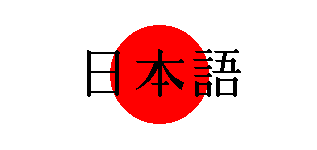

|

Hiragana is the most basic writing system Japanese uses, and much easier to learn than Kanji. It's the squigly set of writing seen above (the first symbol is hi, pronounced "hee", ra, pronounced "rdaa", etc). There are 46 different Hiragana symbols. All Kanji can also be written in Hiragana. In Hiragana, each symbol is almost always pronounced the same way (unlike the Kanji for "sun," which can be read at least 4 different ways).

Katakana is usually used for imported words, like names of people and items, things, ideas, etc. that are new to Japan. Usually, the words have to be adapted to Japanese pronounciation, like my name. In English, it is spelled Nathan, pronounced like "Nay-thun." In Japanese, it is written using the katakana symbol for ne, then the "-" symbol to double the vowel in ne, then a sa, then the syllabic "n." This sounds confusing, but you'll understand later once we reach the pronounciation page. Here's my name written in katakana:

It's pronounced kind of like "Nay-sahn" which isn't very different from "Nay-thun." If you want to learn how to write your name in Japanese, send me an e-mail to [email protected].

Kanji is one of the most complicated writing systems in the world. There are over 2,000 different kanji, and most kanji have multiple pronounciations. They can, however, be easier to read, since a lot of kanji make up a whole word. Also, some kanji are made up of other kanji. For example, if you combine the kanji for sun and moon and distort them a bit, you'll wind up with a different kanji that means "bright light." Don't worry too much about kanji for now, unless you're serious about reading Japanese. Video games are usually aimed at young children, and young children in Japan can't read all the kanji.

